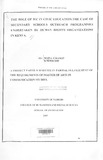| dc.description.abstract | This study sought to determine the impact of Information, Education and Communication (lEC) intervention strategies used by Human Rights organizations to create the desired Human Rights Education (HRE) so as to reduce Human Rights violations in secondary schools in Kenya, It is about two decades since the introduction of multipartism in Kenya, With multipartism, Human Rights Non-Governmental Organizations proliferated all over the country, Their core interest was to educate Kenyans about Human Rights, As they endeavored to achieve this mission, these organizations took their efforts to secondary schools as well.
A network dubbed the Forum for Legal and Human Rights Education in Kenyan Schools -
FLEHURE- was formed to coordinate the organizations' efforts in this endeavour, FLEHURE has seen about 500 secondary schools in Kenya benefit from the efforts of the organizations. These organizations have individually trained teachers to teach Human Rights Education in secondary schools in Kenya, At schools, law clubs. comprising members who wiilingly wish to learn and subsequently influence others to respect Human Rights, have been formed. Despite all these efforts, Human Rights violations have continued unabated even in schools where Human
Rights Education has taken place.
This study's objective therefore was to demonstrate the importance of formulating, planning and implementing efficient and effective lEC intervention strategies in the creation of human rights awareness among the target audiences so as to reduce human rights violations in secondary schools in Kenya. From the findings, the study sought to make recommendations to benefit future planners of secondary schools' outreach programmes in Kenya.
The study was undertaken in nine schools drawn at random from a sample of three prov inces in Kenya namely Eastern, Nairobi and Western, comprising Nyanza. The researcher considers the sample to ably represent secondary' school learners in Kenya.
The findings of the study may, therefore, be generalized to all Iearners in secondary schools in Kenva.
The survey method was used in the study. 360 self-administered questionnaires for students and nine for teachers were dispatched. 222 questionnaires for students were retumed, achieving a 61.66 percent response rate. Seven out of nine questionnaires for teachers were returned. This is 77.77 percent. A focused interview guide for use with project planners and implementers as well as existing literature in Human Rights Education in secondary schools in Kenya were also used. All these provided the study with primary and secondary data.
The findings indicate that, either implicitly or explicitly. lEC intervention strategies were used to administer HRE in secondary schools in Kenya. For instance, experts of Human Rights Education, who are professionals in the Legal fraternity, were used on a majority of learners.
Besides, the findings show that all the organizations have embraced the importance of reference groups in changing behavior and attitudes of learners towards Human Rights. The project also found out that interpersonal communication has been exploited to some extent in the attitude and behavior change through networking among teachers and learners in the Schools Outreach Programmes. However, communication of HRE messages and their subsequent attitude and behavior change can be improved through use of a mix of types of communication, particularly
mass communication. There have been serious impediments to the successful adoption of lEC strategies in teaching-learning of Human Rights Education in secondary schools in Kenya. Such problems include big workload for teachers, ShOl1 supply of literature and lack of HRE curricul urn.
It can safely be argued that. given the gratification derived from HRE by bo 11 teachers and students, the efforts of Human Rights NGOs are clearly notable, This points towards the need for Human Rights organizations to continue offering Human Rights Education to secondary school students in Kenya. Twenty years is a long time but it is a short time for Human Rights Organization to achieve considerable attitude and behavior change among secondary school students without quality lEe intervention strategies. If the recommendations given are adopted by planners of HRE in secondary schools in Kenya, the secondary schools' outreach programme will be efficient and effective. | en |

